Since the wedding of Prince William and Kate Middleton is April 29th, I’ve decided to use these six weeks to profile six of the Edwardian era’s most prominent royal weddings. Since Queen Victoria’s family was incredibly large and well-connected, I have a plethora of nuptials from which to choose–my only obstacle is making a decision! For now, I’ll focus on the first wedding which came to mind, the 1906 marriage of Princess Victoria Eugenie of Battenberg & King Alfonso XIII of Spain.
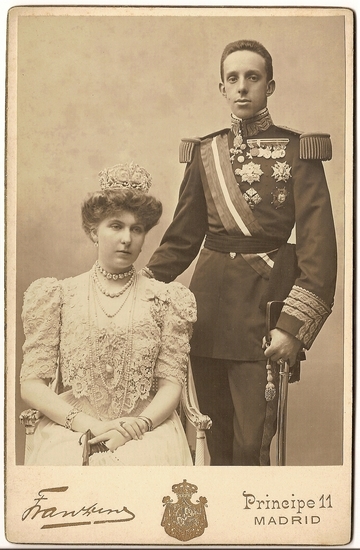
Victoria Eugenie was the only daughter born to Princess Beatrice, the youngest daughter of Queen Victoria, and Prince Henry of Battenberg, who was the son of Prince Alexander of Hesse and by Rhine by his morganatic wife Countess Julia von Hauke. Called Ena by her family, the princess was raised in her grandmother’s household, as Queen Victoria only consented to Beatrice’s wedding to Prince Henry on the condition that she remain at her side. Though her father died when she was nine, and her grandmother five years later, Princess Ena’s life was rather secure and happy.
In contrast, Alfonso’s upbringing was rather unique, since his posthumous birth made him King of Spain the moment he was delivered. His mother, Queen Maria Christina was appointed Regent until he reached his majority in 1902 at sixteen. His ascension to the throne was marked by festivities, bullfights, balls and receptions throughout Spain, and the French newspaper Le Figaro described the young King as “the happiest and best-loved of all the rulers of the earth.” Unfortunately, under his reign Spain lost its last colonies in the Americas (Cuba and Puerto Rico) and the Philippines, and the country was rocked by the anarchist movement. Nevertheless, King Alfonso was a very popular monarch, well loved by the ladies, and considered an excellent sportsman.
Ena and Alfonso met in 1905, when he traveled to England for an official visit. Her beauty and her platinum hair caught Alfonso’s eye at a dinner hosted by her uncle, King Edward VII, and though he had initially paid marked attention to her cousin, Princess Patricia of Connaught, his eye was now on Princess Ena as a future bride. Their match was not without obstacles, mainly that of religion, since Alfonso was a Roman Catholic and Ena was obviously Anglican. Another obstacle was that of rank: Ena was merely a Serene Highness, and a descendant from a morganatic marriage, which Alfonso’s mother, the daughter of Archduke Karl Ferdinand of Austria, viewed as non-royal and therefore made Ena and Alfonso an unequal match. Lastly, there was the issue of haemophilia, which ran through the royal family, and from which her own brother Leopold suffered. Alfonso would not be deterred, and after a year’s worth of speculation, Alfonso’s mother granted her consent. Ena converted to Roman Catholicism, and King Edward raised her status to that of Royal Highness, taking care of two of the more pressing conflicts to their marriage.
As with the Dollar Princesses, Ena’s trousseau was of much interest to celebrity wedding watchers, and the New York Times obliged their avid curiosity:
All of her trousseau, with the exception of the wedding dress, were made in London, and the robes, cloaks, evening and tea gowns, petticoats, and under linen were on exhibition before the wedding.
A dainty dress is of white mousseline de soie flowered with miniature roses. A morning gown is of fine spotted lawn over palest blue, inset with Valenciennes laces. A beautiful princess robe is in spotted lawn, made to wear over many different colored slips. A pale blue China silk empire morning robe is fastened in front with blue rosettes and ends. Another morning gown is of white lawn over pale blue, inserted at equal distances with Valenciennes lace. A smart morning gown is composed entirely of English embroidery in a very openwork design.
Among the simple day gowns are many composed on linen. The bodices in many instances are made after the American blouse style, with touches of red and blue embroidery. One of the many dressing jackets is made of the palest blue and white Zenana, edged with quaint silk embroidery. A handsome day dress is composed of ivory crepe de chine, the bodice arranged with finest guipure lace and tucked squares of crepe de chine, the centres of which are delicately embroidered with colored rosebuds and set together with insertions of Valenciennes lace…
The wedding day of May 31, 1906 was met with cheers and celebrations across the country, and especially in Madrid, where Ena and Alfonso were to be wed in the Royal Monastery of San Geronimo. Mrs. Humphrey, aka “Madge” of Truth left her impressions of the wedding:
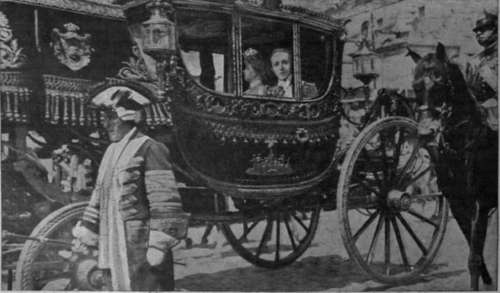
The sun shone warmly down on the streets of Madrid. King Alfonso motored to El Pardo, where the bride was staying, and at a very early hour they attended Mass together. After breakfasting together with the bride’s mother, Princess Henry of Battenberg, Princess Ena, clothed in white, but with a blue feather in her hat, entered an electric brougham with King Alfonso, who was in admiral’s uniform.
Stately Ceremonial
On arrival at the Ministry of Marine, shortly after eight o’clock, the bride went to dress, Queen Maria Christina arranging the bridal veil. Our handsome English Princess, tall, fair, and graceful, looked superb in her wonderful silver embroideries and draperies of priceless lace. A tiara of diamonds and pearls overtopped the wreath of orange-blossom in her abundant hair, and a priceless pearl necklace adorned her beautiful neck.
The stately procession which preceded the King’s carriage passed through streets crowded with excited people. Red and yellow – the Spanish colours – were everywhere, on the Venetian masts, in the flags, and amongst the floral decorations. Every house had its draped balcony, either with tapestries, or red and yellow cloth.
The King, looking extremely happy, and boyishly excited, acknowledged the greetings of the populace in his usual genial way. Half an hour later the procession of the bride, somewhat smaller than that of the King, passed along the same streets, likewise preceded and followed by cavalry. The church of San Jeronimo was the scene of the ceremony. It is small and dark, but for this occasion was lighted with electric lamps, of which there were many thousands. The aisle and chancel were covered with fine carpets, and the entire church was decorated with flowers.
The Bridal Processions
Gathered closely together, space being somewhat limited, there was a picturesque assembly, including practically every uniform of Europe, diplomatic and military. The canopy under which both bride and bridegroom walk in Spanish marriages is white and gold. Under it walked King Alfonso, four of the greatest nobles in the land bearing the canopy. Then followed a wait of half an hour, the king looking rather thoughtful, and a trifle impatient, sitting erect in his throne chair. At last came the notes of “God Save the King,” and Princess Ena entered. She passed up the aisle beneath the canopy, closely holding the hand of Queen Maria Christina, her mother following half a pace behind on her left.
King Alfonso and his bride knelt before the altar, which had previously been converted into a bank of flowers, and from which rose the Crucifix. After the lapse of a moment or two, while engaged in prayer, King Alfonso rose to his feet with that impulsive movement to which we have all become accustomed in this youthful monarch, and, passing behind his bride, went to his mother, stooped over her, and kissed her hand. Princess Ena, seeing this, followed his example, left her place, and kissed Princess Henry, her mother, who shed tears. This little episode was, in fact, extremely touching.
The Royal pair having again resumed their places, the short, impressive ceremony began. It was followed by the nuptial Mass, conducted by the Archbishop of Toledo and the Bishop of Nottingham, who, on the previous evening, had received the bride’s confession. It will doubtless be remembered that Princess Ena had changed her faith in view of her approaching marriage. The Royal couple now left the altar, and proceeded hand in hand to the dais, where they remained seated, a focus for all eyes, while the choral portions of the service were rendered magnificently by the choir. It was a wonderful sight. A little below them stood the Queen-mother, next to her chair of state, clad in her beautiful majestic dress and jewels, and on either side knelt the heralds, in their gorgeous uniforms.
Signing The Register
The music finished, the newly-married pair walked arm-in-arm to a place close by, where a beautiful old monastery had once stood, a ruined cloister being almost the only remaining vestige of it. Here the marriage register was signed, the King having chosen this spot a few days before the wedding. On a table, covered with crimson cloth, stood the necessary implements. The corner of the cloisters had been screened off with fine tapestries of world-wide renown, on which were depicted scenes from Don Quixote.
Saluting The King And His Bride
The bridal procession was then formed to return to the church, the Prince of Wales (afterwards King George) closely following the bride and bridegroom and the Queen-mother. Then came the Princess of Wales (Queen Mary), and the Archduke Francis Ferdinand of Austria. When the church was reached, the guests dispersed according to strictest rules of Spanish etiquette and precedence, the latter being reversed in this instance. Those of lowest rank passed first in couples before the dais, bowing low and curtseying to the bride and bridegroom, now seated in their chairs of state. Each couple passed directly out of the church after having made their reverence. The Prince and Princess of Wales were the last to leave, with the exception of the Queen-mother; and, when she had made her deep curtsey to her son and his bride, the two latter walked down the church under the canopy, and drove off to the Palace in a coach drawn by eight cream-coloured horses, with nodding white plumes. The crowd cheered incessantly, the joy-bells rang, cannons boomed, flags waved, and the red and yellow flowers and streamers made a wonderful spectacle in the sunshine.
The Ending In Tragedy
Then, two or three minutes later, as will be recollected, a dastardly outrage was attempted upon this happy and smiling couple, whose bravery and self-possession, with their sudden change from joy and brightness to a scene of suffering and cruelty, was remarkable. An equerry almost dragged the Royal couple from their carriage, and hurried them into another coach. It was a miraculous escape, and the eventful day will for ever be marred to the King and Queen of Spain by the memory of the innocent victims killed or sadly injured by the bomb that was intended for them.
Notwithstanding this outrage, the brave young couple showed themselves to the people on arrival at the Palace, when they were greeted with a storm of cheers. On the following day they drove through the streets of Madrid without escort, trusting only to the chivalry of their people. Nor was this trust misplaced, for the populace formed a guard of honour and prevented any harm coming to their King and his young Queen.
Further Reading:
Born to Rule: Five Reigning Consorts, Granddaughters of Queen Victoria By Julia P. Gelardi

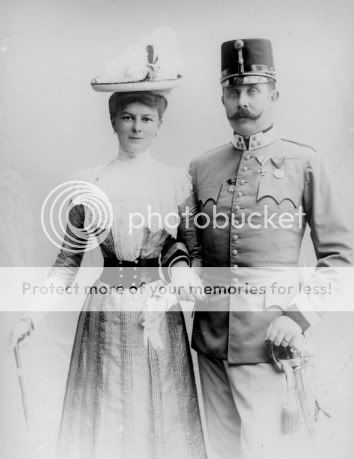
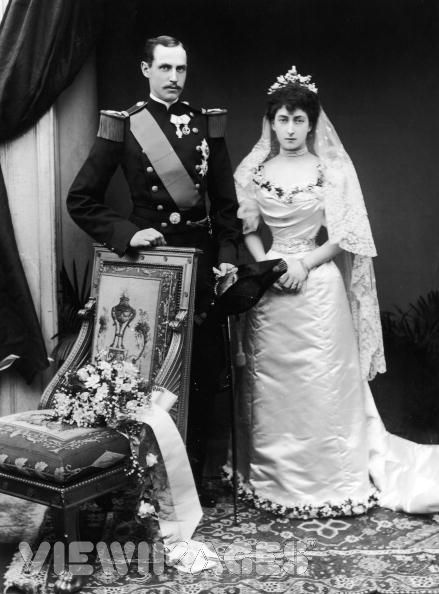
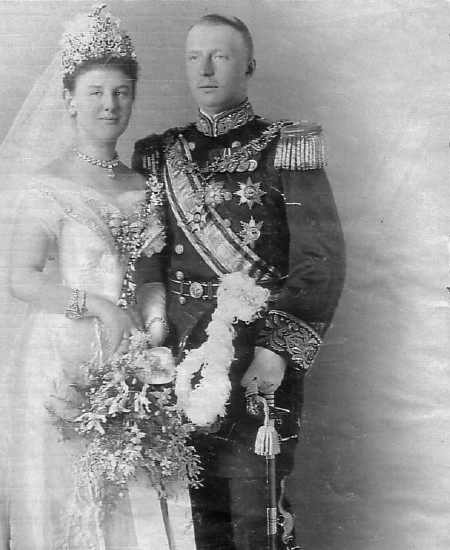
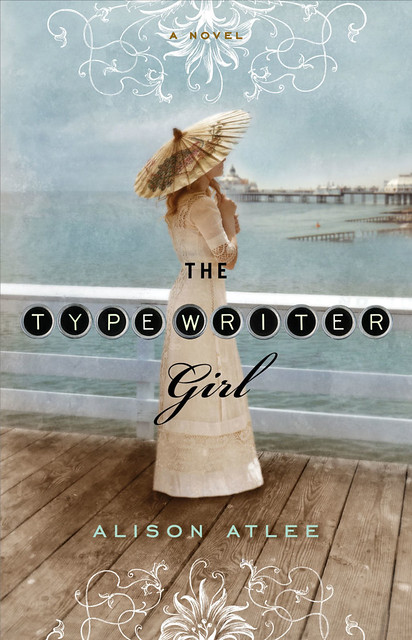
Royal weddings always fascinate, don’t they, especially when there is no commoner involved. In this case, there would have been utter fascination in the entire Spanish world and the entire British empire.
My key issue in this particular story is this: a Catholic Spanish royal marrying a Church of England British royal must have created endless anxiety attacks in both families. How did the British royal family deal with Ena’s conversion to Roman Catholicism? What was Ena’s relationship with her own family like, in the years after the wedding?
The New York Times wrote numerous articles about the widespread hostility to Ena’s conversion on both sides of the Atlantic from Catholics and Protestants. According to the Gelardi book I referenced, Edward VII was not sympathetic to her becoming a Catholic even though he facilitated the match (HSH to HRH, etc). I can only imagine that the rest of the family felt the same. But Ena wasn’t the first Anglican princess to convert to another religion and experience he personal anguish and hostility of others to do so–Princess Alice’s daughters, Alix and Elizabeth of Hesse and Rhine both had to convert from Lutheranism to Russian Orthodoxy to marry Tsar Nicholas and his uncle Grand Duke Sergei, respectively. Considering how fractious religious relations could be in the late 19th and early 20th centuries, I can only imagine what life was like for converts of any social class.
Thank you for this article. I’ve always been fascinated by the lives of Queen Victoria’s grandchildren.
Thank you Elizabeth! I am fascinated by Victoria’s extremely large family. Plenty of stories and drama.
What a fascinating article. Did I miss a description of her wedding gown? The gown in the photo is exquisite.
Hi Nancy, according to Royal Romances of To-day:
Princess Victoria Eugenie of Battenberg was never a HSH, Her Serene Highness. In December 1886, (year before she was born), Queen Victoria elevated all sons and daughters of the Battenbergs to Highness. She was born Her Highness Princess Victoria Eugenie. A month before she was married to King Alfonso XIII the reigning King Edward VII elevated her to Her Royal Highness. (HRH) in order that the marriage appear more equal.